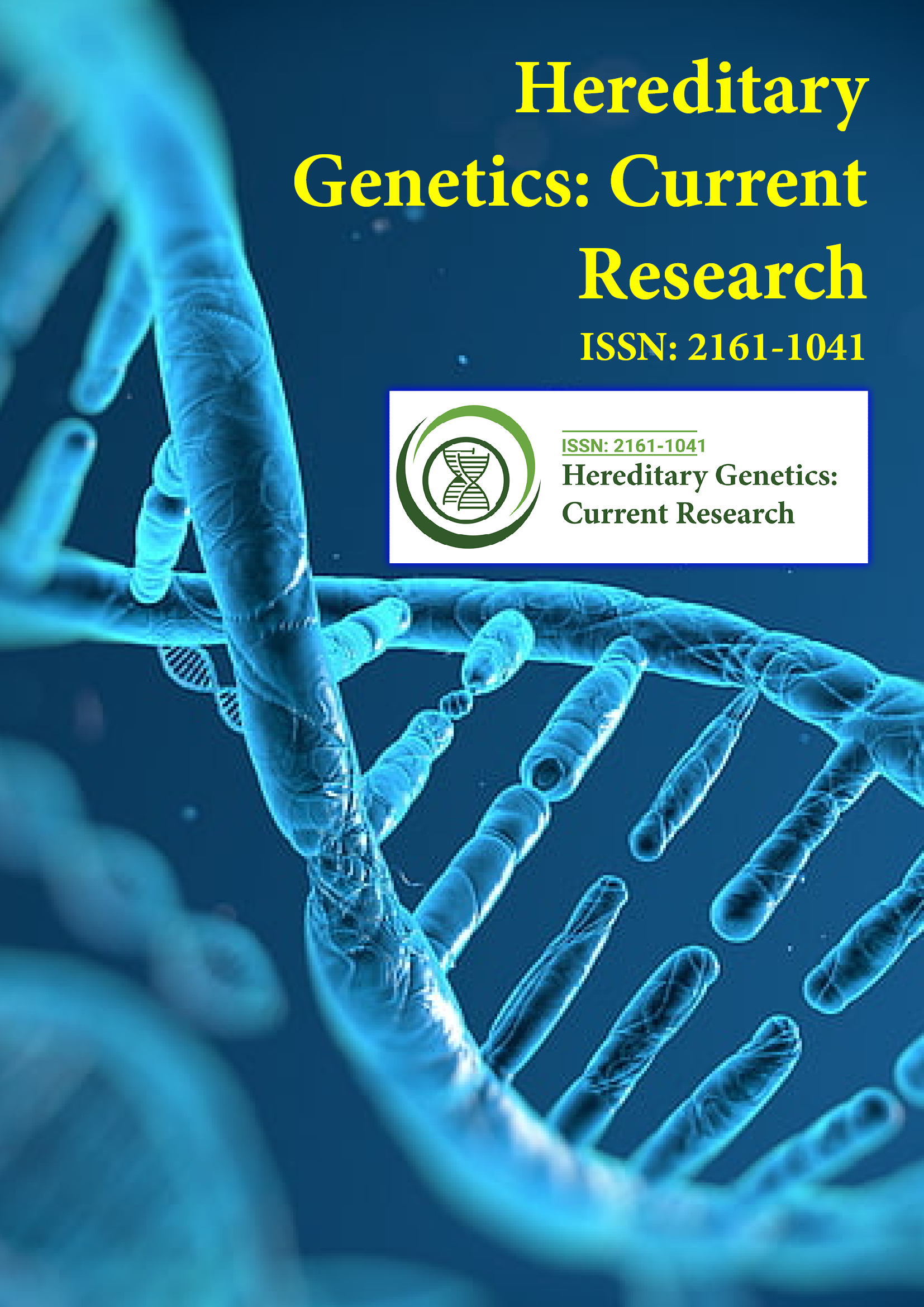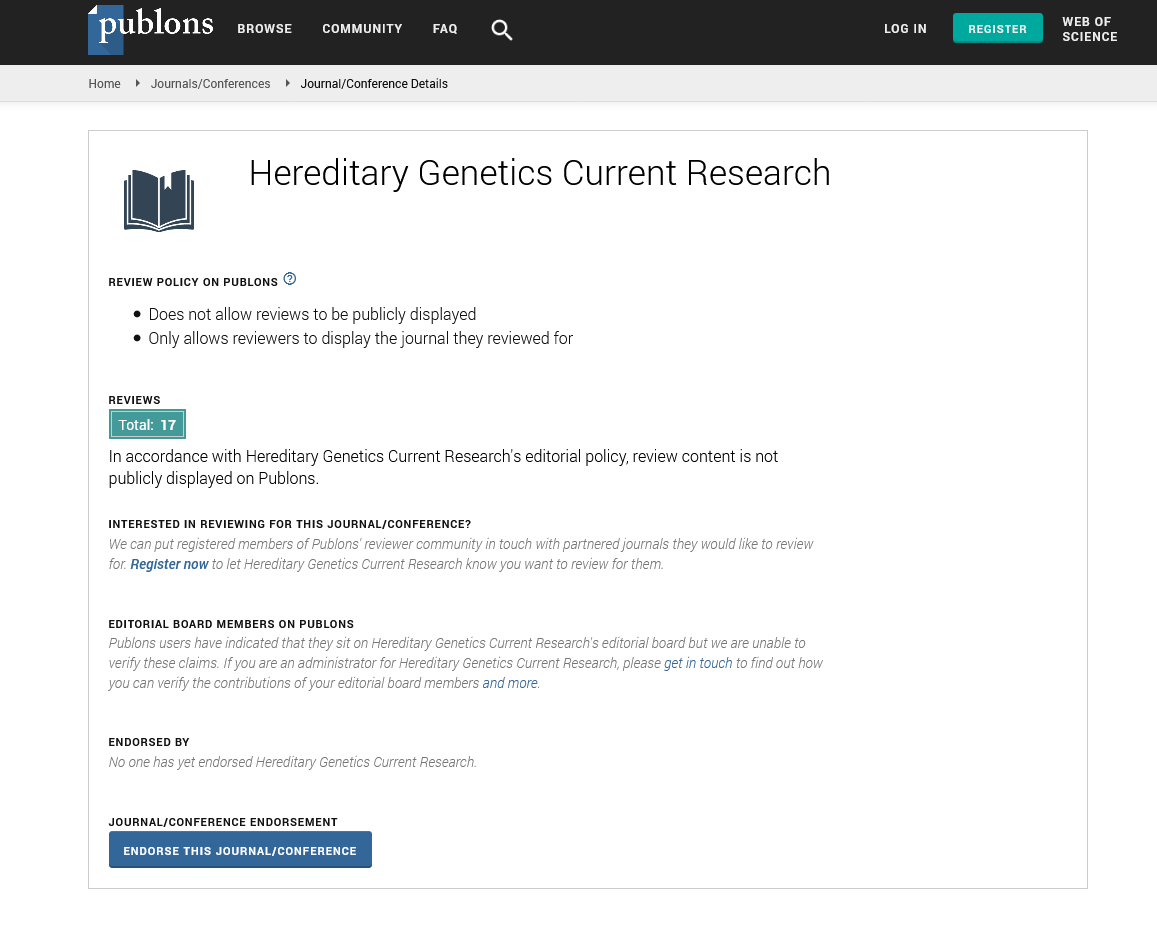Indexed In
- Open J Gate
- Genamics JournalSeek
- CiteFactor
- RefSeek
- Hamdard University
- EBSCO A-Z
- NSD - Norwegian Centre for Research Data
- OCLC- WorldCat
- Publons
- Geneva Foundation for Medical Education and Research
- Euro Pub
- Google Scholar
Useful Links
Share This Page
Journal Flyer

Open Access Journals
- Agri and Aquaculture
- Biochemistry
- Bioinformatics & Systems Biology
- Business & Management
- Chemistry
- Clinical Sciences
- Engineering
- Food & Nutrition
- General Science
- Genetics & Molecular Biology
- Immunology & Microbiology
- Medical Sciences
- Neuroscience & Psychology
- Nursing & Health Care
- Pharmaceutical Sciences
Opinion Article - (2024) Volume 13, Issue 1
Molecular Marker Analysis of Genetic Diversity in Chuanminshen violaceum
Feliciano Gomez*Received: 27-Feb-2024, Manuscript No. HGCR-24-26564; Editor assigned: 01-Mar-2024, Pre QC No. HGCR-24-26564 (PQ); Reviewed: 15-Mar-2024, QC No. HGCR-24-26564; Revised: 22-Mar-2024, Manuscript No. HGCR-24-26564 (R); Published: 29-Mar-2024, DOI: 10.35248/2161-1041.24.13.278
Description
Chuanminshen violaceum is a plant species endemic known for its medicinal properties and ecological importance. As climate change accelerates, understanding the genetic diversity and potential suitable habitats for this species is critical for its conservation and management. This article examines the genetic diversity of Chuanminshen violaceum and evaluates its potential habitats in the context of changing climate conditions.
Genetic diversity of chuanminshen violaceum
Genetic diversity is a critical component of a species' ability to adapt to changing environmental conditions. High genetic diversity within a species allows for a greater range of responses to environmental stressors, enhancing resilience and survival. For Chuanminshen violaceum genetic diversity studies provide insight into the species' adaptability and long-term viability.
Methods of genetic diversity analysis
Genetic diversity in Chuanminshen violaceum is typically assessed using molecular markers, such as microsatellites (simple sequence repeats) or Single Nucleotide Polymorphisms (SNPs). These markers provide information about genetic variation at various levels, including within populations and between populations. Recent studies have employed these methods to evaluate the genetic diversity of Chuanminshen violaceum. Results have shown varying levels of genetic diversity across different populations. Some populations exhibit high genetic variability, which is a positive indicator of adaptability.
Implications of genetic diversity for conservation
High genetic diversity within Chuanminshen violaceum populations suggests that these plants have the potential to adapt to changing climates. However, populations with low genetic diversity are at greater risk of extinction, as they may lack the genetic resources needed to adapt to new conditions. Conservation strategies should focus on preserving genetic diversity by protecting diverse populations and facilitating gene flow between isolated populations.
Potential suitable habitat for chuanminshen violaceum
Identifying potential suitable habitats for Chuanminshen violaceum under climate change scenarios is essential for its conservation. This involves modeling the species' habitat preferences and predicting how these preferences might shift as climate conditions change.
Habitat modeling techniques
Habitat modeling typically uses environmental variables such as temperature, precipitation, and soil conditions to predict suitable habitats for a species. Techniques like Species Distribution Modeling (SDM) or climate envelope modeling can be employed to forecast how suitable habitats for Chuanminshen violaceum might change. Recent models have projected shifts in suitable habitats for Chuanminshen violaceum under various climate scenarios. These projections indicate that as temperatures rise and precipitation patterns change, the current habitats of Chuanminshen violaceum may become less suitable. However, new areas with appropriate conditions may become available, providing potential new habitats for the species.
Potential habitats under future climate scenarios
Models predict that the suitable habitat for Chuanminshen violaceum wills likely shift to higher altitudes or latitudes as temperatures increases. In regions where the climate becomes too harsh, the species may face increased competition from other plants or may not be able to survive. Conversely, newly available areas that become suitable due to changing conditions may offer opportunities for colonization. Identifying these potential new habitats is critical for planning conservation strategies and facilitating the relocation or assisted migration of Chuanminshen violaceum. To ensure the survival of Chuanminshen violaceum amidst climate change, several conservation strategies should be considered. Protecting the existing habitats of Chuanminshen violaceum is essential. This includes managing and conserving the natural environments where the species currently thrives. In situ conservation efforts should focus on maintaining habitat quality, preventing habitat destruction, and mitigating other threats such as invasive species. These collections can be used for future restoration efforts or to reintroduce Chuanminshen violaceum.
Assisted migration involves relocating Chuanminshen violaceumto newly identify suitable habitats. This strategy requires careful planning and monitoring to ensure that the species can establish and thrive in the new locations. The genetic diversity of Chuanminshen violaceum plays a critical role in its ability to adapt to climate change. Understanding this diversity and predicting changes in suitable habitats are essential for developing effective conservation strategies. By employing genetic analysis and habitat modeling, conservationists can better prepare for the challenges posed by climate change and ensure the continued survival of this valuable plant species. As climate change continues to impact ecosystems globally, it is imperative to prioritize research and conservation efforts for species like Chuanminshen violaceum .Through a combination of in situ and ex situ conservation strategies, along with careful planning for potential habitat shifts can work towards preserving the genetic and ecological heritage of this important plant.
Citation: Gomez F (2024) Molecular Marker Analysis of Genetic Diversity in Chuanminshen violaceum . Hereditary Genet. 13:278.
Copyright: © 2024 Gomez F. This is an open access article distributed under the terms of the Creative Commons Attribution License, which permits unrestricted use, distribution, and reproduction in any medium, provided the original author and source are credited.

